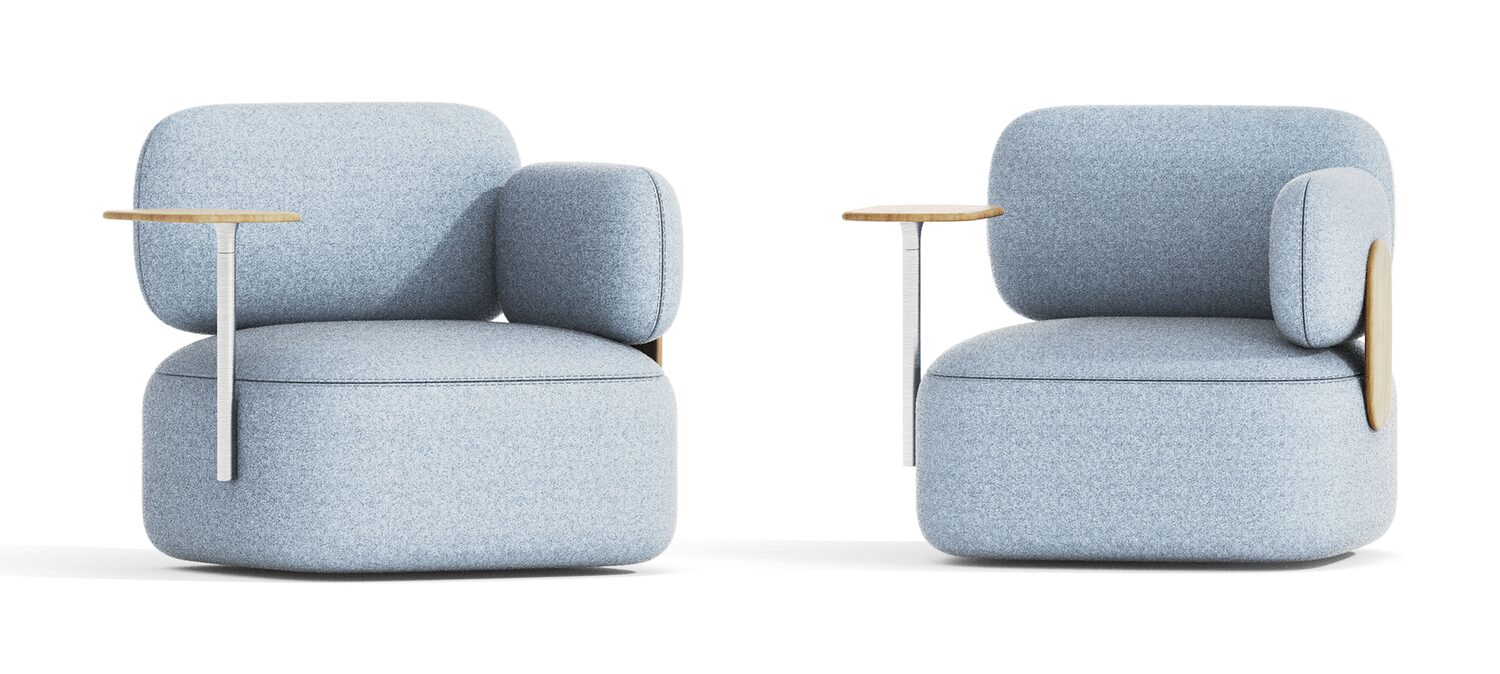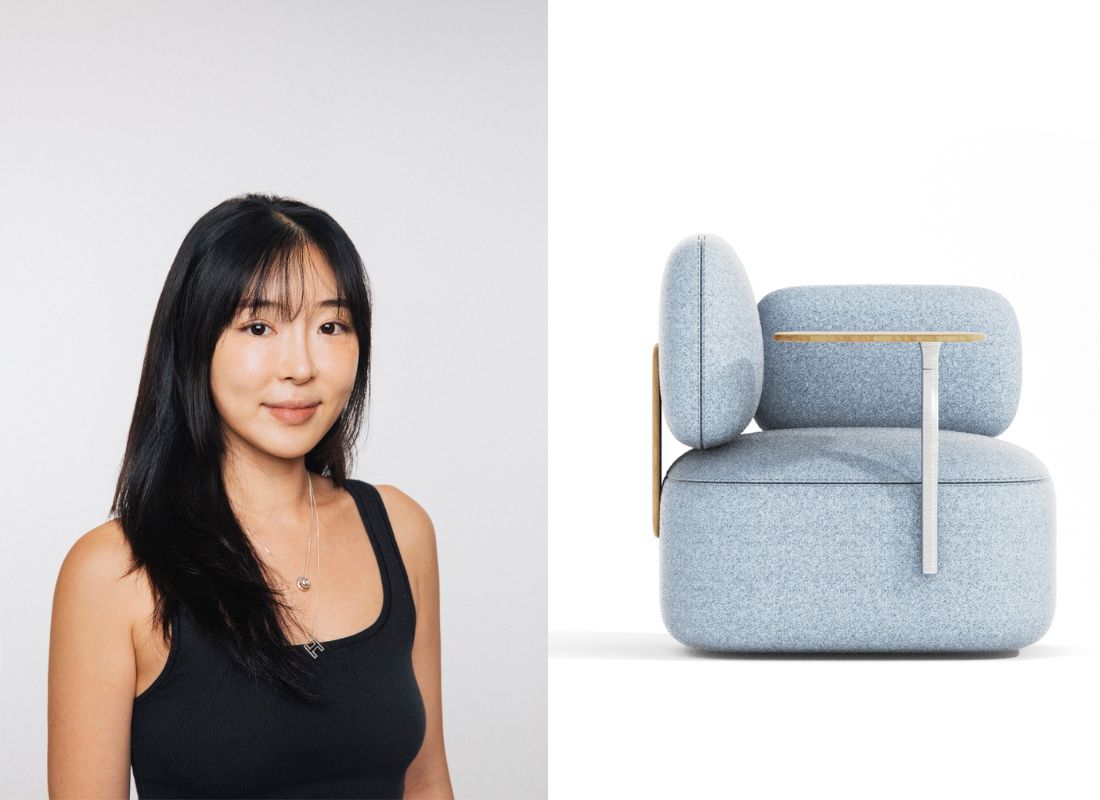
 Can you tell us a bit about yourself and your background? How did design come to have such an important place in your life? I graduated from Art Center College of Design last year, and currently, I work as an industrial designer based in the Bay Area. Before delving into industrial design, I spent a year studying fashion design, which has deeply influenced my approach to product design. My understanding of color and materials stems from my foundation in fashion. Growing up, my mother ran an art academy where I was exposed to numerous drawings and paintings. We often drew together, forging a strong bond that made art a meaningful part of my life. This experience inspired me to aspire to design products that evoke positive memories, carry profound meaning, and endure over time. Can you elaborate on the concept behind the design of the Otto Lounge Chair? With the shift towards remote and hybrid work becoming the norm, the boundaries between work and personal life have become less clear. I aim to integrate elements that evoke warmth, comfort, and a sense of home into office environments, thereby enhancing the workplace experience. On the other hand, for home settings, I propose solutions that support efficiency and productivity, addressing the common challenges of distractions that often accompany remote work. Can you walk us through the design process? How did the design evolve from your initial idea to the final product? I had initially considered creating furniture suitable for both office and home environments. However, I ultimately decided to move forward with designing a multi-functional lounge chair that could seamlessly transition between these two settings. The initial sketch lacked the soft curvature and cushioning I envisioned, so I dedicated considerable effort to refining its form. This process began with a small-scale cardboard mock-up and progressed to a precise 3D-milled prototype to achieve the desired shape. I particularly focused on ensuring that the wooden elements connecting the cushion and table components complemented the overall design cohesively. How does the Otto Lounge Chair address the need of hybrid living spaces in a post-pandemic world? Otto is a versatile lounge chair designed to offer comfort and functionality that align with evolving lifestyles. With more people working from home and blending their living and working spaces, Otto serves as a multi-functional piece of furniture. Its pivot table feature makes Otto ideal for adapting to the flexible and multifaceted demands of hybrid living spaces, where seamless transitions between work and relaxation are increasingly important. Can you discuss the pivoting table feature and how it perfectly incorporates user needs into the design? The pivot table is a pivotal feature of Otto, carefully tailored to meet user needs. This feature enables Otto to function as a compact workspace for laptops or documents, enhancing productivity in home office settings. What sets it apart is its dual functionality—it can also function as an armrest when not actively in use.
Can you tell us a bit about yourself and your background? How did design come to have such an important place in your life? I graduated from Art Center College of Design last year, and currently, I work as an industrial designer based in the Bay Area. Before delving into industrial design, I spent a year studying fashion design, which has deeply influenced my approach to product design. My understanding of color and materials stems from my foundation in fashion. Growing up, my mother ran an art academy where I was exposed to numerous drawings and paintings. We often drew together, forging a strong bond that made art a meaningful part of my life. This experience inspired me to aspire to design products that evoke positive memories, carry profound meaning, and endure over time. Can you elaborate on the concept behind the design of the Otto Lounge Chair? With the shift towards remote and hybrid work becoming the norm, the boundaries between work and personal life have become less clear. I aim to integrate elements that evoke warmth, comfort, and a sense of home into office environments, thereby enhancing the workplace experience. On the other hand, for home settings, I propose solutions that support efficiency and productivity, addressing the common challenges of distractions that often accompany remote work. Can you walk us through the design process? How did the design evolve from your initial idea to the final product? I had initially considered creating furniture suitable for both office and home environments. However, I ultimately decided to move forward with designing a multi-functional lounge chair that could seamlessly transition between these two settings. The initial sketch lacked the soft curvature and cushioning I envisioned, so I dedicated considerable effort to refining its form. This process began with a small-scale cardboard mock-up and progressed to a precise 3D-milled prototype to achieve the desired shape. I particularly focused on ensuring that the wooden elements connecting the cushion and table components complemented the overall design cohesively. How does the Otto Lounge Chair address the need of hybrid living spaces in a post-pandemic world? Otto is a versatile lounge chair designed to offer comfort and functionality that align with evolving lifestyles. With more people working from home and blending their living and working spaces, Otto serves as a multi-functional piece of furniture. Its pivot table feature makes Otto ideal for adapting to the flexible and multifaceted demands of hybrid living spaces, where seamless transitions between work and relaxation are increasingly important. Can you discuss the pivoting table feature and how it perfectly incorporates user needs into the design? The pivot table is a pivotal feature of Otto, carefully tailored to meet user needs. This feature enables Otto to function as a compact workspace for laptops or documents, enhancing productivity in home office settings. What sets it apart is its dual functionality—it can also function as an armrest when not actively in use.  Can you elaborate on the choice of materials and how they made the cut? I believe the standout feature of Otto lies in the wooden pieces that connect the cushions. I aimed to select a material that could not only create iconic pieces but also harmonize with any environment. Therefore, wood was a natural choice due to its ability to blend seamlessly into various spaces. These pieces were CNC milled to achieve the precise forms required. What were some of the challenges you faced while designing the Otto Lounge Chair? What did you learn from the process? Of course, I spent a lot of time refining the proportions. Since this was my first experience making furniture, I initially lacked knowledge of furniture construction. However, with excellent guidance from class instructors, I learned how to construct and assemble a frame structure. Furthermore, through communication and learning from upholsterers, I was able to overcome these challenges. Congratulations on winning the SIT Emerging Furniture Designer of the Year award! What is next for you and your studio? Are there any new designs you’re working on that you can tell us about? Thank you! It’s truly an honor to win the award, especially the title of Emerging Furniture Designer of the Year. Since graduating, I’ve been gaining valuable experience at a design agency, where I’ve had the opportunity to work on various products. While I don’t have immediate plans for new designs, I look forward to pursuing personal projects in the future, where I can apply the skills I’ve acquired in the industry so far. Please stay tuned for what’s to come. What advice would you offer to new designers entering the field? Since there are tons of furniture out there, With countless furniture options available, it’s essential to think about how your design can be differentiated from the other. As a designer, I believe it’s crucial to not only focus on aesthetic appeal but also to understand and cater to the evolving behaviors and environments of people. Learning from others and asking as many questions as possible are invaluable in this process. I continue to learn new things every day, recognizing that learning is a continuous journey without end. VIEW ALL WINNERS.
Can you elaborate on the choice of materials and how they made the cut? I believe the standout feature of Otto lies in the wooden pieces that connect the cushions. I aimed to select a material that could not only create iconic pieces but also harmonize with any environment. Therefore, wood was a natural choice due to its ability to blend seamlessly into various spaces. These pieces were CNC milled to achieve the precise forms required. What were some of the challenges you faced while designing the Otto Lounge Chair? What did you learn from the process? Of course, I spent a lot of time refining the proportions. Since this was my first experience making furniture, I initially lacked knowledge of furniture construction. However, with excellent guidance from class instructors, I learned how to construct and assemble a frame structure. Furthermore, through communication and learning from upholsterers, I was able to overcome these challenges. Congratulations on winning the SIT Emerging Furniture Designer of the Year award! What is next for you and your studio? Are there any new designs you’re working on that you can tell us about? Thank you! It’s truly an honor to win the award, especially the title of Emerging Furniture Designer of the Year. Since graduating, I’ve been gaining valuable experience at a design agency, where I’ve had the opportunity to work on various products. While I don’t have immediate plans for new designs, I look forward to pursuing personal projects in the future, where I can apply the skills I’ve acquired in the industry so far. Please stay tuned for what’s to come. What advice would you offer to new designers entering the field? Since there are tons of furniture out there, With countless furniture options available, it’s essential to think about how your design can be differentiated from the other. As a designer, I believe it’s crucial to not only focus on aesthetic appeal but also to understand and cater to the evolving behaviors and environments of people. Learning from others and asking as many questions as possible are invaluable in this process. I continue to learn new things every day, recognizing that learning is a continuous journey without end. VIEW ALL WINNERS.